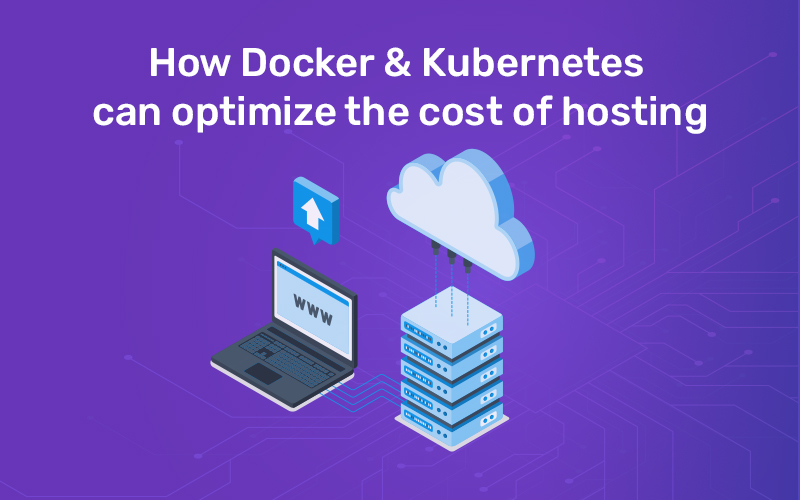How Docker & Kubernetes Can Optimize the Cost of Hosting?

Container orchestration and container technology are revolutionizing the management and deployment of applications in a multi-node distributed domain at scale. After Google open-sourced Kubernetes in 2014, many tech organizations worldwide have chosen to leverage this container platform’s benefits, increasing recognition and popularity in the tech arena.
In 2019, we saw a wide agreement that containers controlled by container orchestration structures make the board, application CI/CD and sending at a scale much more productive and effective.
But, containers’ real benefits and functional advantages are often covered up under a layer of typical terminologies known to only a few specialists in the field.
What is Docker and Kubernetes container? Don’t worry; we will help you uncover and understand these container terminologies.
What is Kubernetes?
It is an open-source container-orchestration system used for automating app management, scaling and deployment. Kubernetes is designed by Google, and now it is handled by the Cloud Native Computing Foundation. Undoubtedly, it is a trustworthy container system ruling the market.
According to the CNCF survey, the utilization of Kubernetes in production in 2020 was 93%, up from 78% in 2019.
Since Kubernetes is a widely utilized Docker containerization platform, it is intended to work and support all container technology that meets the standards of Open Container Initiative (OCI).
What is Docker?
Now come to know what Docker technology is? It is a tool that utilizes OS-level virtualization that assists in developing, running and deploying apps by using containers.
Containers are not similar in nature, feature and contain the essentials to run an application: program, system tools, system libraries, runtime, and settings. Containers like Docker interact with each other via well-defined and needed mediums.
Cost-Saving Benefits of Containers
We know how container structure protects more efficient use of resources than VMs. But, containerization cost-saving benefits are limitless and don’t end there.
Let’s check how Docker & Kubernetes can optimize the cost of hosting
1. Containers are free and open-source
Widely used container platforms like Docker are free and open source to use. They are developed around standardized technologies such as user namespaces, systemd, cgroups and other Linux libraries and concepts and open-source Linux distributions that assist OS-level virtualization and container isolation. However, while some VMs like KVM are free to use, others like VMware are very costly when used on a large scale.
2. Lower management and configuration costs
The time has gone when containers require teams to spend much more time and cost. In this post-container era, configuring and managing servers has become very cost-effective.
Professional docker consulting firms can assist you in leveraging the benefits of low management and configuration cost while using containers.
Now containers have all dependencies packaged, self-contained and portable to run; they are less reliant on the dedicated server configuration and environments.
Also, containers today are no longer jumbled with the host environment. As a result, you can save more money and time on server configuration with networking, system libraries, environmental variables, dependencies etc.
3. Lower infrastructure costs
Now we know that containers can be faster and more lightweight than VMs, which are immutable. OS-level virtualization utilized containers to enable deploying several containers on a single host. Docker and Kubernetes-like containers don’t need duplicate OS images to run.
4. Better teamwork between infrastructure engineers and developers
Container technologies make better teamwork and cooperation between infrastructure engineers and developers. Developers can easily create the app, package it into the required container with all settings and dependencies, and then hand it over to infrastructure engineers that only require knowing what storage and network requirements the container has.
These engineers are no longer required to install all these dependencies manually and tune the server for app functioning. The container will utilize the internal and self-contained settings to coordinate with the host kernel and utilize the required resources.
5. Efficient resource management
Kubernetes uses a highly efficient resource management model run at the cluster levels, pod, and container. At the container level, developers can easily limit specified raw RAM and CPU values and assign resource requests to containers.
All such factors control the maximum and minimum amount of available resources to the container during its lifecycle. ByBesetting a varied number of limit/request rations, you can make different classes of pods – assured, burstable, and best-effort – relying on the needs of your app.
Additionally, Kubernetes backs namespace-wide resource management, enabling you to define default resource requests, request quota, and resource constraints in a given namespace.
In this way, you can assure that your cluster always has the required resources to decrease cloud infrastructure costs for running applications.
6. Low maintenance costs
Containers include environment parity of product development, testing and deployment. All these environmental factors are uniform with containers. It results in huge cost-saving benefits as uniform environments offer easier maintenance even with smaller teams.
Conclusion
Finally, we can say that Kubernetes and Docker have immense cost-saving potential. A Docker development consulting helps to better utilize containers to decrease infrastructure and hosting costs.
Containers can share a single OS and are lighter than VMs. Additional benefits of containers include low maintenance costs, better coordination between engineering teams, faster CI/CD pipelines.
With Kubernetes like container technology, you can save more with rolling updates, efficient resource management, application scheduling, and scaling.
Recent Posts
Deep Learning Explained: Understanding the Brain Behind AI
The Intersection of AI and IoT: Creating Smarter, Connected Environments
The Evolution of AI: From Simple Algorithms to Neural Networks
The Role of AI in Sustainable Development
Scaling New Heights: Integrating Advanced Technologies in Startup Product Engineering